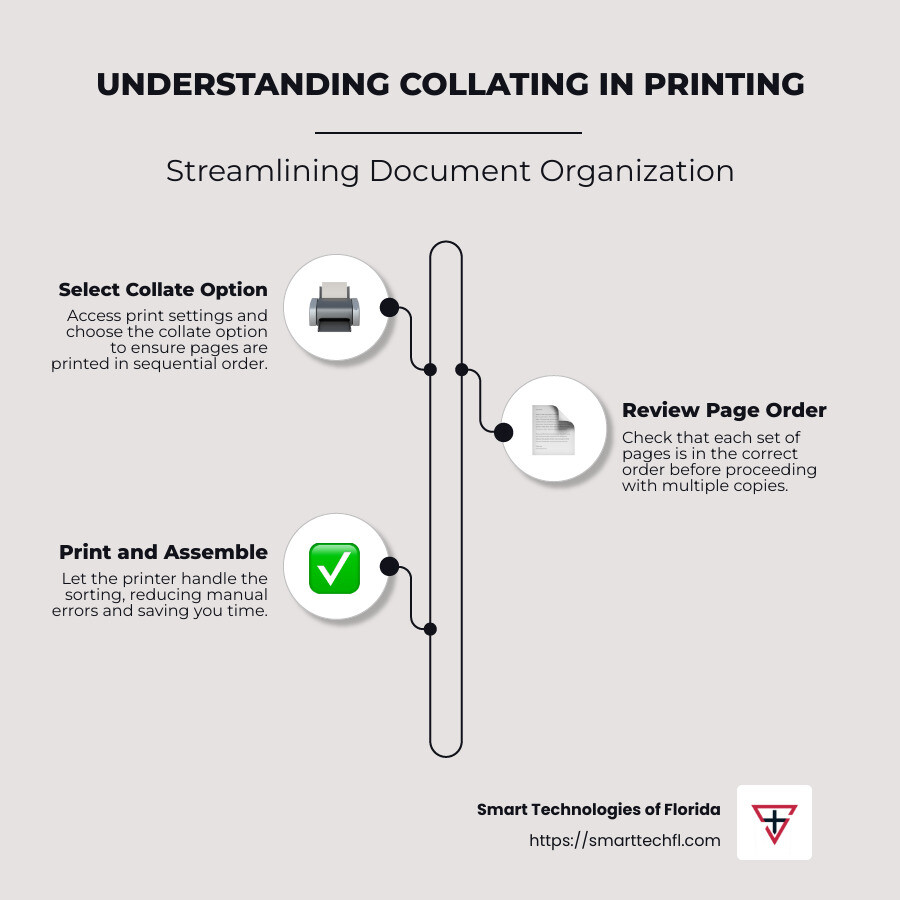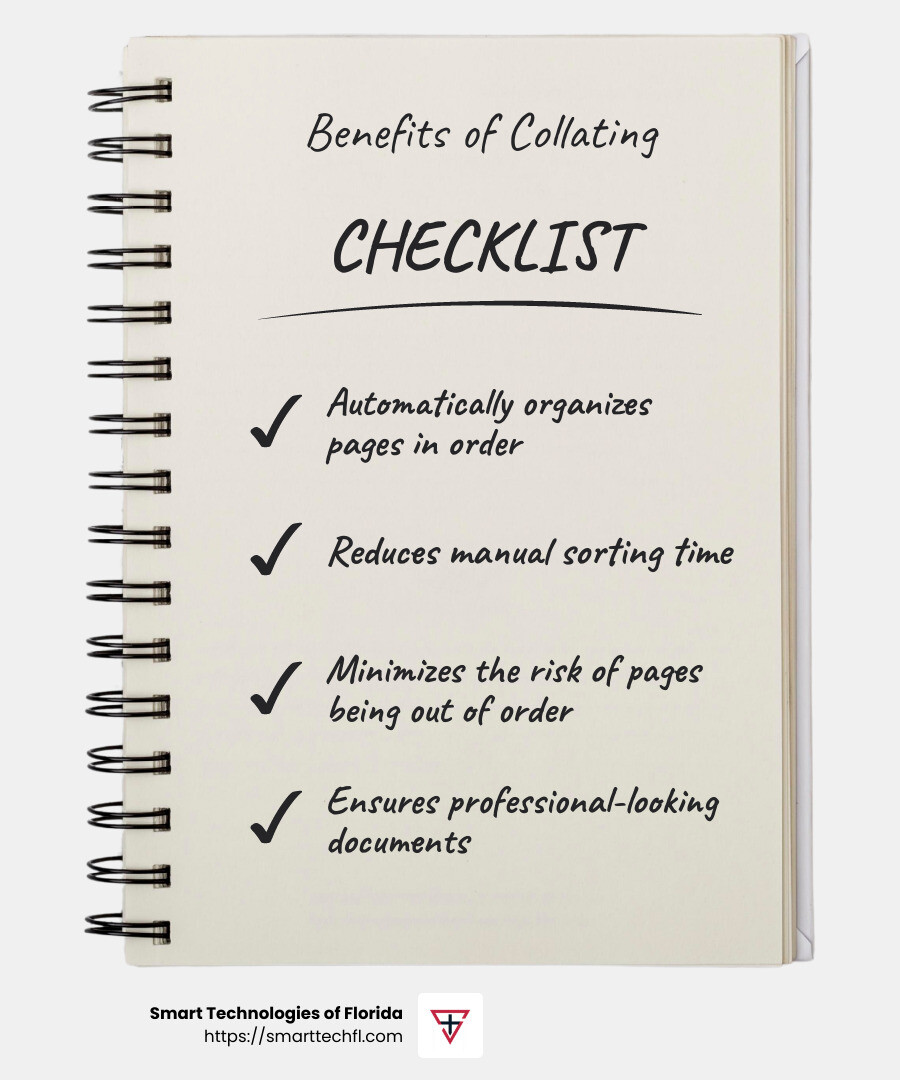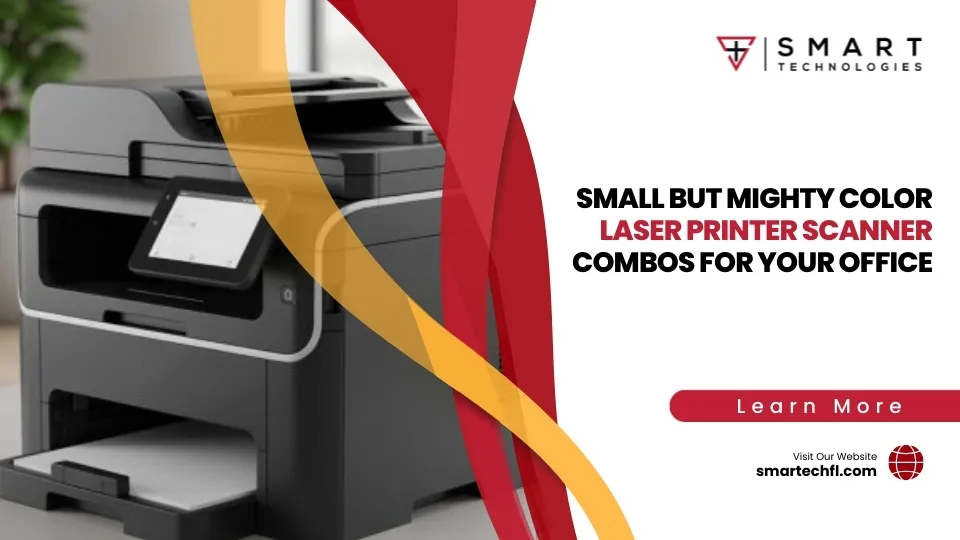Collate Printing: The Key to Organized Documents
What is the meaning of collate printing? When dealing with multi-page documents, collating means printing each set of pages in sequential order. For example, printing pages 1, 2, and 3 in order for each complete set.
Understanding document organization is crucial whether you’re running a business in Daytona Beach or managing academic materials. One common way to ensure your documents are orderly is through the process of ‘collating.’ What is the meaning of collate in printing? Simply put, it’s arranging your printed pages so every set is in the correct order, like printing pages 1 through 3 in that exact sequence for each copy.
Why does this matter? Properly collated documents not only look professional but also save time and reduce errors. Instead of sorting pages manually, your printer does the heavy lifting, allowing you to focus on more important tasks. In today’s world, where efficiency is key, understanding the nuances of collated printing can drastically improve your business operations.

What is the Meaning of Collate in Printing?
When we talk about collating in printing, we’re referring to the process of arranging multi-page documents in a specific sequence. Imagine you’re printing a 10-page report. With collating, each copy comes out in order: pages 1 to 10, then the next set, and so on. This keeps your documents neat and organized, eliminating the need to sort them manually.
Benefits of Collating
Collating offers several advantages that make it invaluable, especially in busy work environments:
- Time-Saving: Automatically organizing pages in order means you don’t have to spend time sorting them yourself. This is particularly helpful when dealing with large print jobs.
- Convenience: With collated documents, everything is ready to go as soon as it’s printed. This means no extra effort is needed to prepare them for meetings or presentations.
- Accuracy: By reducing the risk of pages being out of order, collating ensures that every document is complete and correct. This minimizes mistakes and maintains a professional appearance.

Common Use Cases
Collating is especially useful in various scenarios where maintaining a specific page order is essential:
- Reports: Ensures that each report is in the correct sequence, making it easy to read and understand.
- Presentations: Keeps slides or pages in the intended order, ensuring a smooth delivery.
- Manuals and Instructions: These documents need to be in a logical order for users to follow procedures correctly.
- Invoices and Billing Documents: Ensures that all financial information is printed in an organized manner, reducing errors and confusion.
In workplaces, whether you’re printing reports for a meeting or preparing instruction manuals, collating ensures everything is perfectly ordered and ready to use. This feature is not just a convenience; it’s a necessity for maintaining efficiency and professionalism.
How to Enable or Disable Collating
Adjusting the collate setting on your printer is straightforward once you know where to look. Here’s how you can manage this feature to suit your needs:
Print Settings
When you decide to print a document, the first step is to access the print settings. This is usually done through the print dialog box that appears after you hit ‘Print’. Within this box, you’ll see various options, including the one for collating.
Toggle Option
In the print dialog box, look for a checkbox or toggle labeled “Collate”. This is your key to enabling or disabling the feature. If you want your documents to print in sequence (like pages 1 to 10 for each copy), ensure the box is checked. If you prefer to print all copies of one page before moving to the next (like ten copies of page 1, then ten copies of page 2), uncheck the box.
User Manual
If you’re having trouble finding the collate option, your printer’s user manual can be a great resource. Most manuals include detailed instructions on how to steer the print settings. You can often find a digital version of the manual on the manufacturer’s website if you’ve misplaced the physical copy.
Whether you choose collated or uncollated printing depends on your specific needs. For multi-page documents, collating is usually beneficial, but for single-page flyers or separate stacks, uncollated might be the way to go.
Understanding how to control the collate function empowers you to handle your print jobs efficiently, ensuring your documents are organized just the way you need them.
Should You Choose Collate or Uncollated Printing?
Choosing between collate and uncollated printing depends on the purpose of your print job and how you want your documents organized. Let’s explore when each option is most beneficial.
Examples of When to Use Each
Multi-Page Documents
For reports, manuals, or presentations, collating is your best friend. It ensures each copy of your document comes out in the correct sequence. This is essential when you need complete sets ready for distribution without any extra sorting.
Single-Page Flyers
If you’re printing single-page flyers or handouts, uncollated printing is more efficient. This way, you print all copies of the same page together. It’s ideal when you need multiple copies of one page, like when preparing for a large event.
Custom Print Jobs
Sometimes, you have a mix of needs. Imagine printing a training manual with chapter dividers or specialty pages. Here, you might use a combination of both. Print the main document collated, and handle custom pages or inserts separately. You can manually add these specialty pages later, ensuring everything is in the right order.
Purpose of Print Job
- Sequential Order Required: Use collate for projects that need organized, multi-page sets.
- Separate Stacks Needed: Opt for uncollated when printing identical single pages in bulk.
- Custom Needs: Combine both methods for complex jobs requiring special handling.
Understanding these differences helps you decide the best approach for your specific printing needs. Whether it’s about efficiency or organization, choosing the right option makes your work easier and more professional.
Frequently Asked Questions about Collate Printing
Should I Use Collate When Printing?
Collate printing is a must when dealing with multi-page documents that need to be assembled in a specific order. Think about reports, manuals, or presentations. When you use the collate function, each copy of your document comes out as a complete set. This means pages are in the correct sequence, ready for distribution or binding.
If you’re printing something like a 20-page report and need 10 copies, collating saves you from manually sorting through 200 pages. It’s a big time-saver and ensures accuracy.
However, if you’re printing single-page documents or items like flyers, you might not need to collate. In these cases, printing all copies of one page at a time is faster and more efficient.
Does Collated Mean Double-Sided?
No, collated and double-sided are two different things. Collation refers to the order of pages, while duplex printing means printing on both sides of the paper.
You can have collated documents that are single-sided or double-sided. For example, a collated 10-page report can be printed single-sided with each page on a separate sheet, or double-sided with pages 1 and 2 on the front and back of the first sheet, and so on.
Always check your print settings to ensure you’re getting the right combination of collation and duplex printing for your needs.
What is the Difference Between Collate and Uncollated Printing?
The main difference lies in the page order and print sequence.
- Collated Printing: Produces complete sets of multi-page documents in sequence. For a 10-page document, you’ll get pages 1 through 10 in order for each copy.
- Uncollated Printing: Prints all copies of one page before moving on to the next. If you print a 10-page document uncollated, you’ll first get all copies of page 1, then all copies of page 2, and so on.
Choosing between collate and uncollated depends on your project needs. If you want organized sets, go for collated. If you need many copies of the same page, uncollated is the way to go.
Conclusion
At Smart Technologies of Florida, we understand the pivotal role that document organization plays in effective business communication. By leveraging the power of collate printing, businesses can achieve seamless document management and presentation. This strategic change not only saves time but also improves the accuracy and professionalism of your printed materials.
Our people-centric approach is designed to empower businesses by aligning technology solutions with your unique goals. With over 23 years of experience, we specialize in tailoring digital solutions that drive strategic change and innovation.
Whether you’re assembling complex reports, crafting detailed manuals, or preparing polished presentations, collate printing ensures that your documents are organized and ready for immediate use. This method eliminates the hassle of manually sorting pages, allowing you to focus on what truly matters—delivering value to your clients and stakeholders.
For businesses looking to streamline their printing processes, our Printers and Copiers service page offers comprehensive solutions custom to meet your organizational needs. Explore how we can assist you in achieving superior document organization and overall business change.
With Smart Technologies of Florida, you can trust that your printing projects are in expert hands, ensuring that every document reflects the professionalism and quality your business stands for.
Was this post useful?












